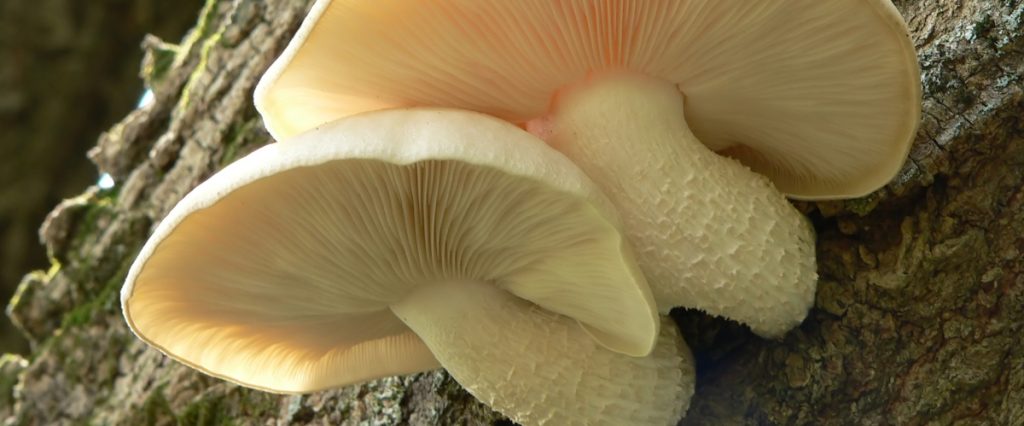Oyster mushrooms are one of our favorite mushrooms and an excellent choice for beginner mushroom growers as they’re hardy and fast-growing.
Another great thing about oyster mushrooms is the variety of strains available.
These include summer types like phoenix oysters that prefer warmer temperatures and oysters with striking colors like pink, blue and yellow oysters.
Elm oysters, although not true oyster mushrooms, are also worth considering as they’re perfect for growing indoors and have larger fruiting bodies than other oysters.
Read on to learn what elm oysters are, where they grow, how to identify them, how to grow them at home and how to store, clean and cook elm oyster mushrooms with recipes to try.
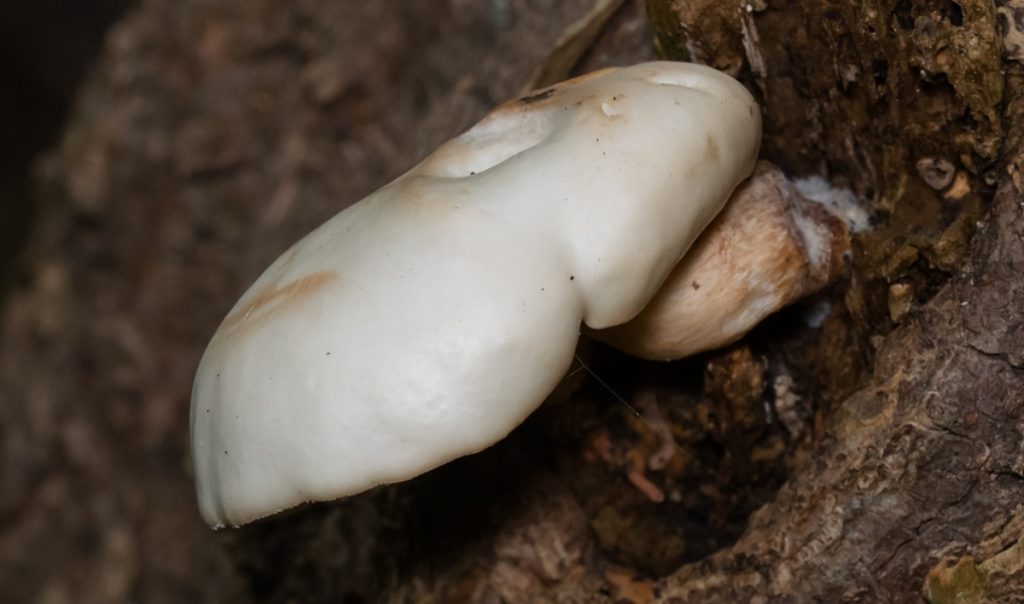
What Are Elm Oyster Mushrooms?
Elm oyster mushrooms are edible oyster-shaped mushrooms found high up on the trunks and branches of broadleaf deciduous trees.
Although similar in appearance to other oyster mushrooms, they do not belong to the same Pleurotus genus as other oysters.
The scientific name for elm oyster mushrooms is Hypsizygus ulmarius which gives clues on where to find them.
In Latin, the word ‘hypsi’ means high up, and ‘zygus’ means a yoke, thus describing where you’ll find them on trees. The second word ‘ulmarius’ means of elm trees, as elms are one of their favorite host trees.
Elm oysters, also known as white elm mushrooms or Shirotamogitake in Japanese, are delicious and, like other oyster mushrooms, have a host of health benefits.
Where Do Elm Oyster Mushrooms Grow?
You’ll find elm oyster mushrooms growing high-up in deciduous and mixed woodlands in temperate parts of the world, including Europe, Asia and North America.
They typically grow individually or in small groups but may also appear in dense clusters growing from branch scars and wounds in living elms and box elders.
Occasionally you’ll also find them on other hardwood trees like beech, maple, willow and oak.
Elm oysters need temperatures between 55 and 65°F (13 and 18°C) to fruit, and you’ll find them from late summer through autumn and into early winter, depending on local conditions.
Although widespread and easy to spot, elm oysters are a sought-after delicacy for mushroom foragers as they’re often too high up in trees and out of reach.
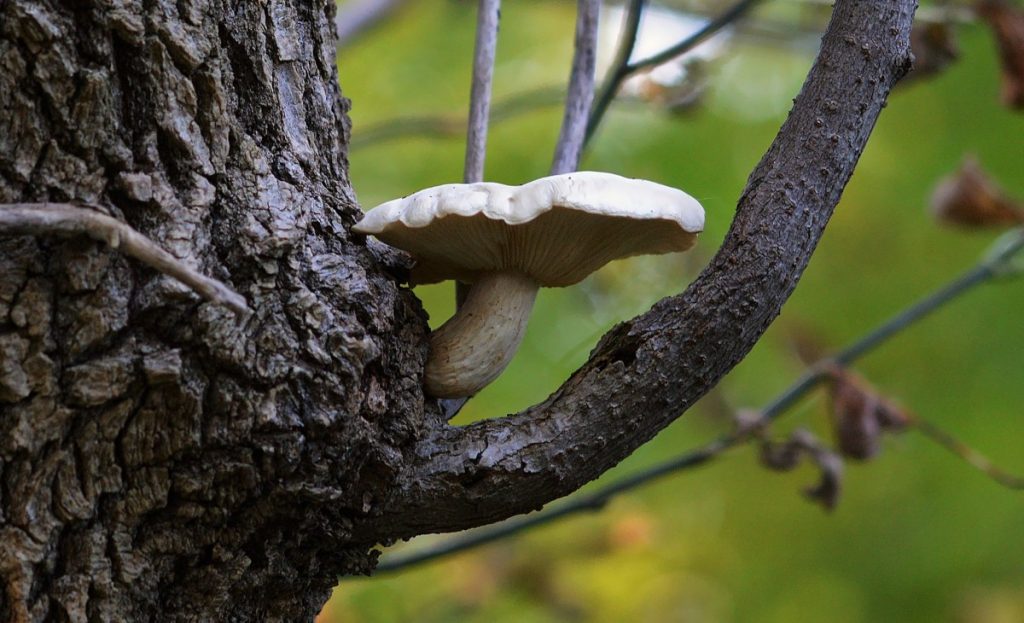
Why Are Elm Oyster Mushrooms Growing on My Elms?
Elm oyster mushrooms grow from wounds in trees. If you’ve pruned your elms or they’ve lost branches, the remaining scars create moist, hospitable environments for elm oyster mushroom spores.
The spores that land in these scars grow into single-celled hyphae that combine with other hyphae to form mycelium that then expands, feeding on nutrients from the tree.
When the elm oyster mycelium has enough nutrients and weather conditions are ideal, it forms fruiting bodies or mushrooms as we know them.
Researchers list elm oyster mushrooms as parasites and saprotrophs, as it’s unclear whether they feed on the living or dead tissue on host trees.
Although they usually grow on live trees, you’ll also find them on dead, decaying trees and can successfully cultivate them on straw and sawdust blocks.
How to Identify Elm Oyster Mushrooms
Elm oyster mushroom identification is relatively easy because of where these mushrooms grow. Most oyster mushroom species grow lower down on fallen branches or at the base of decaying tree stumps.
If you’re still unsure, there are several excellent mushroom identification apps that can help you to know if you have elm oysters or one of the more common Pleurotus oyster mushroom species.
Elm oyster mushrooms are larger than other oyster mushrooms and range in color from white to buff, cream or tan, depending on their substrate and habitat.
Their smooth caps are usually 2.3 to 5.9 inches (6 to 15 cm) in diameter but can grow up to 11.8 inches (30cm).
When young, their caps are convex but flatten out as they age, and the center becomes slightly sunken.
The upper surface of the cap sometimes develops cracks, forming patterns that look like scales.
Elm oyster mushroom stems are 2 to 4 inches (5 to 10cm) long and usually grow perpendicular to the tree and then curve upwards to form the cap.
Their tightly packed gills start white and become cream-colored as the mushroom matures.
If you make a spore print from an elm oyster mushroom, it will be white to buff in color.
Unlike other oyster mushrooms whose gills continue down the stem, elm oyster mushroom gills attach to but do not run down the stem.

Elm Oyster Mushroom Look-Alikes
Fortunately, most similar mushrooms found growing on trees are other edible types of mushrooms.
But, there is a poisonous look-alike that you need to be aware of, especially if you live in Australia, Japan or India.
If you are new to mushroom foraging, it’s best to take an experienced mycologist with you to confirm identification, and never eat mushrooms unless you’re 100% sure they’re safe.
Here are some elm oyster mushroom look-alikes:
1. Pleurotus Oyster Mushrooms
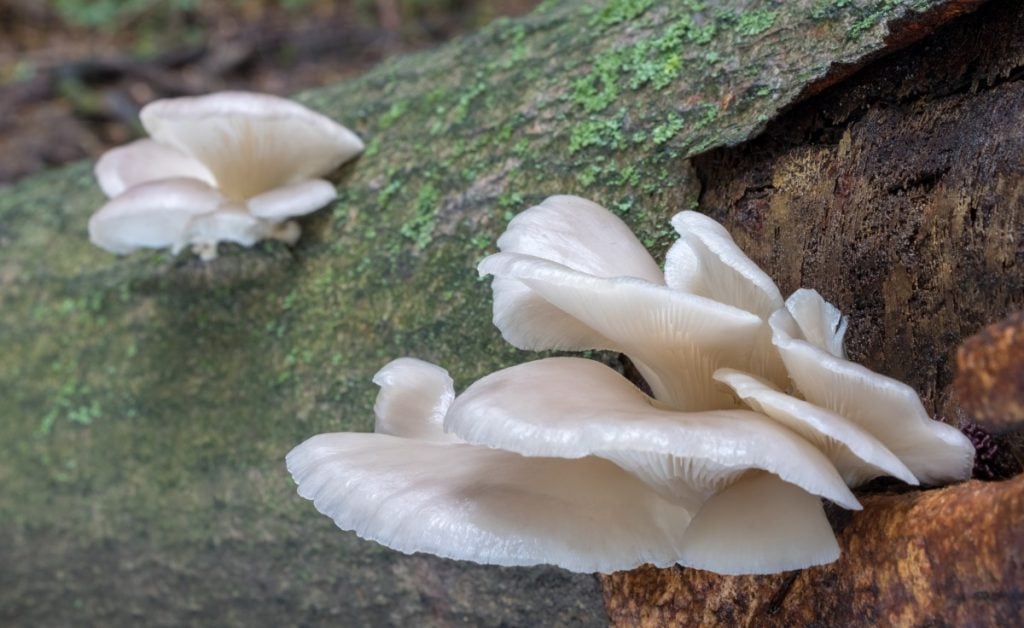
The elm oyster mushroom is sometimes confused with strains of phoenix oyster (Pleurotus pulmonarius) or florida oyster (Pleurotus florida), which can look very similar.
These oyster mushrooms grow on dead and dying hardwood trees and often have similar white to cream caps.
Another similar oyster mushroom, although smaller, is the aspen oyster mushroom (Pleurotus populinus) that grows on the wood of dead and dying aspens and cottonwoods.
One of the easiest ways to tell elm oyster mushrooms apart from these oyster mushrooms is by looking at their caps and gills.
The caps of Pleutorus oyster mushrooms are flatter, fan or oyster shaped and often have slightly scalloped edges.
Although mature elm oyster mushroom caps fan out and flatten, the edges stay curved inwards, giving them more convex, typical mushroom-shaped caps.
The gills are probably the most easy-to-spot difference between elm oyster mushrooms and other oyster mushrooms.
Pleutorus oyster mushrooms have decurrent gills that run almost the whole way down the stem, while elm oyster mushrooms’ gills only attach to the very top of the stem.
2. Ivory Funnel (Clitocybe Dealbata)
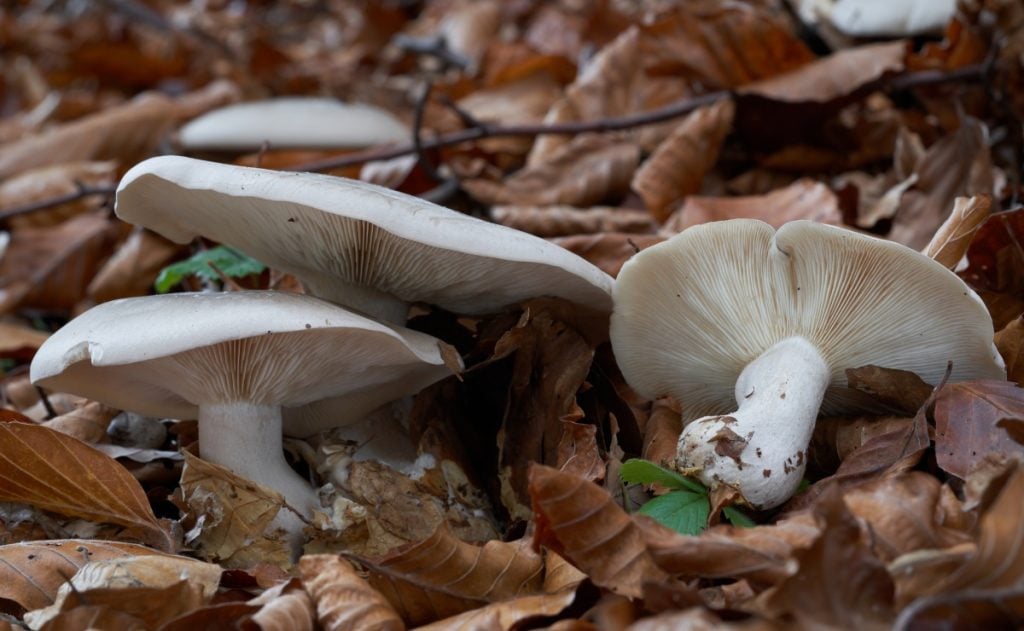
The Ivory funnel is a poisonous mushroom that looks very similar to the elm oyster mushroom but grows out of the ground and not on trees.
If someone gives you foraged mushrooms, and you’re not sure which species of mushroom you have, ask where they found them, as this can help with identification.
The ivory funnel’s nickname is ‘the sweating mushroom’ because if you eat them, symptoms are excessive sweating, abdominal pain, diarrhea, nausea, labored breathing and blurred vision.
3. Beech Mushrooms (Hypsizygus tessellatus)
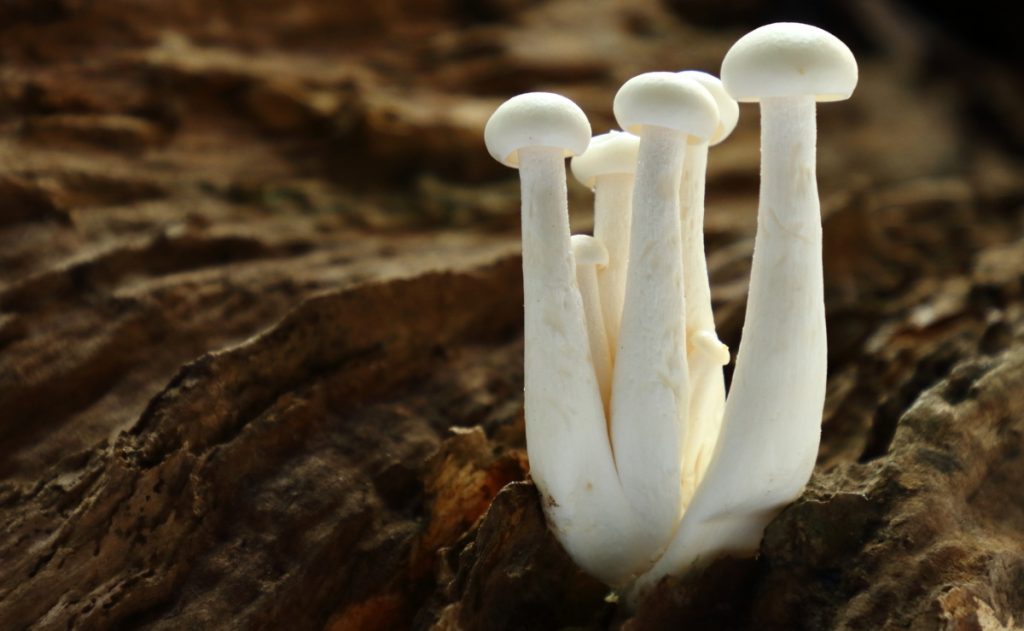
Beech mushrooms are another edible mushroom in the same genus as elm oyster mushrooms. They also grow high up in trees and sometimes look like young elm oyster mushrooms.
But when mature, it’s easy to tell them apart as elm oysters are much larger than beech mushrooms and often grow individually or in small clusters.
Beech mushrooms have shorter stems than elm oysters and small round caps and usually grow in dense clusters of 7 or more on dead beech, aspen, poplar, maple, elm or fir trees.
How to Grow Elm Oyster Mushrooms
You can grow elm oyster mushrooms indoors on pasteurized straw or amended sawdust blocks or outdoors on elm or beech logs.
Elm oysters are excellent for indoor cultivation as they’re hardy, fast-growing mushrooms that can tolerate high levels of CO2.
They’re almost as easy to grow as other oyster mushrooms, and you can grow them using the same techniques.
Like other oyster mushrooms, after inoculation, they don’t need much maintenance other than regular misting.
Another advantage of growing elm oysters is that they don’t produce as many spores as other oysters, which helps prevent allergies.
Elm Oyster Mushroom Grow Kit
We recommend first-time mushroom growers start with an elm oyster mushroom grow kit that comes with a ready-to-grow colonized block of substrate.
When your grow kit arrives, put it in a spot with suitable fruiting conditions, cut an opening in the bag and mist the substrate regularly.
Once you’ve successfully grown mushrooms with grow kits, and want to learn more and experience the entire growing process, try making your own fruiting blocks.
This process involves ordering mushroom grain spawn, preparing and inoculating bulk substrate, then placing it in bags, buckets or other containers and leaving it to incubate.
Our article on growing oyster mushrooms has step-by-step instructions for growing oyster mushrooms indoors.
And, if you prefer to grow mushrooms outdoors, our comprehensive guide to growing mushrooms on logs will take you through the process.
How Long Do Elm Oyster Mushrooms Take to Grow?
When grown indoors with a kit, you’ll usually see the first signs of pinning, the formation of tiny baby mushrooms, 5 to 10 days after placing it in fruiting conditions.
Baby elm oyster mushrooms grow fast, doubling in size daily, and you could have your first harvest a week later.
If you are growing elm oysters using mushroom spawn and a bulk substrate, it will take 2 to 3 weeks for the mycelium to fully colonize the substrate before you can initiate pinning.
And, incubation takes much longer if you decide to grow elm oyster mushrooms on logs.
It will take your elm oysters approximately 7 months to fruit on poplar logs and up to 12 months on beech logs. But your logs will provide mushrooms for several years instead of only one season.
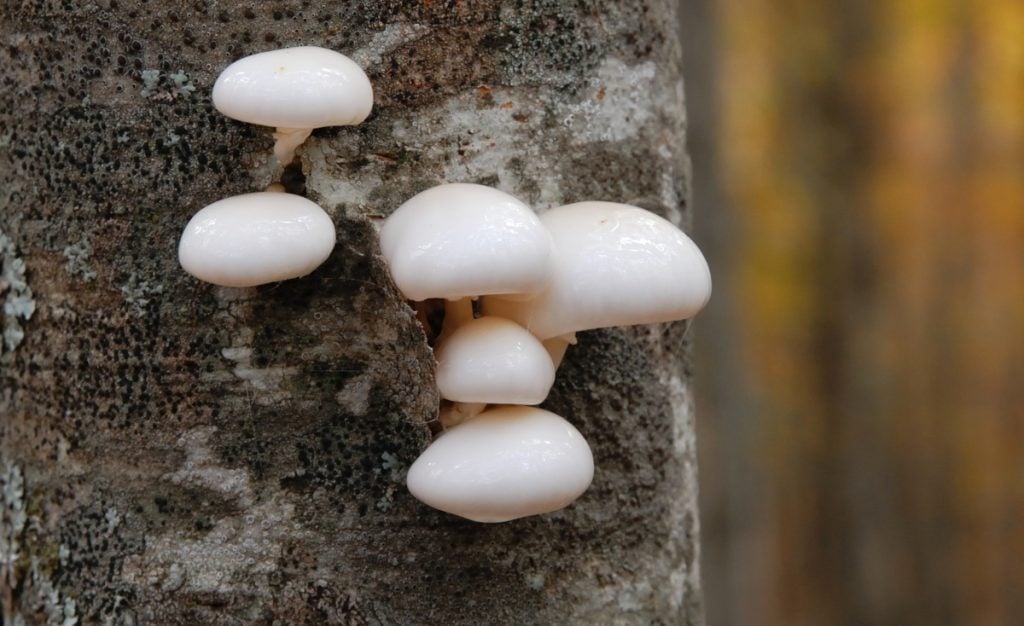
When to Harvest Elm Oyster Mushrooms
Unlike other oyster mushrooms, elm oysters continue to increase in mass after their convex caps flatten.
Usually, you would harvest other oyster mushrooms just before their caps flatten and curl upwards, as this is a sign they’re mature and about to drop their spores.
It’s best to harvest Pleurotus oysters before they drop their spores and cover your kitchen or grow room with dust-like spores.
But, to get larger yields, leave elm oysters a little longer and don’t harvest them as early.
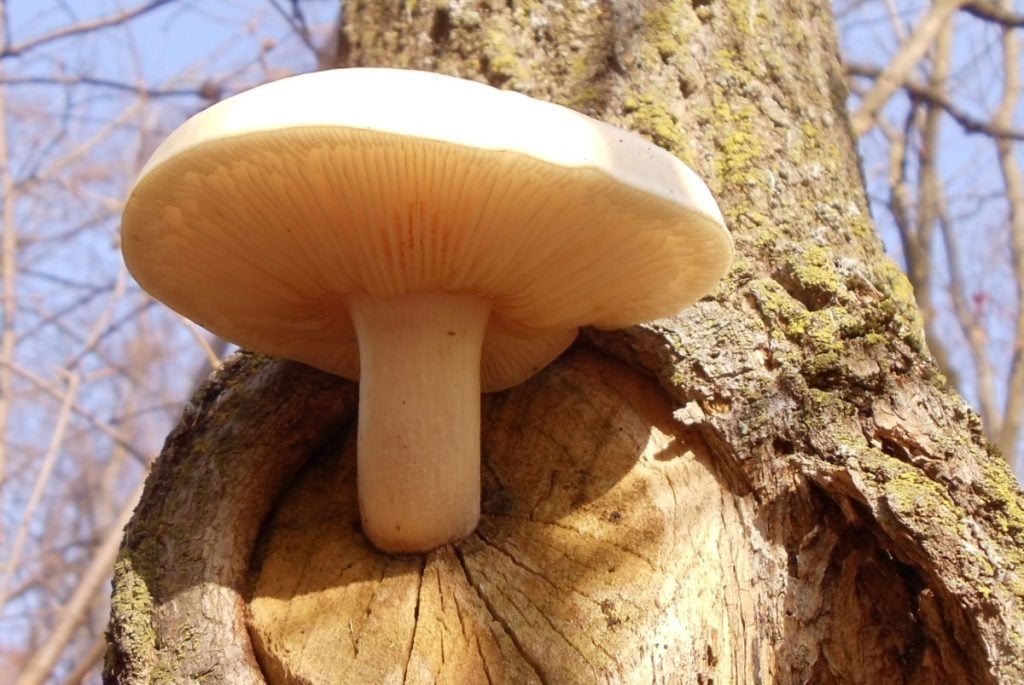
Elm Oyster Mushroom Taste
Elm oysters are firm with a delicate aroma and mild nutty flavor.
When cooked, they have a meaty texture making them a good meat substitute for vegetarian or vegan recipes.
They don’t taste the same as other oyster mushrooms, and some people feel their size, taste, and texture make them superior. But not everyone agrees.
The best way to decide is to try both and see which you prefer.
Health and Nutritional Benefits of Elm Oyster Mushrooms
Elm oyster mushrooms are not only tasty but also full of nutrients that provide several medicinal benefits.
They’re a great low-fat source of protein for vegetarians and vegans and, on a dry weight basis, contain:
- 23.6% protein
- 2.2% fat
- 52.4% carbohydrates
- 12.9% fiber
Like other oyster mushrooms, they contain many essential minerals and vitamins and are an excellent source of vitamin D.
They also contain several active compounds such as phenol, alkaloids, proteins, tannins, and polysaccharides that give them medicinal properties.
Studies show that elm oyster mushrooms (Hypsizygus ulmarius) possess antioxidant, anti-inflammatory, and antitumor properties.
Our article on the health benefits of oyster mushrooms has more information on the advantages of eating oyster mushrooms.
How to Store Elm Oyster Mushrooms
Elm oysters will only last around 48 hours if you keep them at room temperature, as their large caps dry out very quickly.
But, if you store them correctly in the fridge, they’ll last 4 to 5 days. Our article on how to store mushrooms has more information on the best ways to store mushrooms so they last longer.
Remember it’s best not to rinse or slice your mushrooms until you are ready to use them, as doing this before storing them will reduce their shelf life.
And if you want to keep your elm oyster mushrooms for use at a later date, drying and freezing are both effective methods of mushroom preservation.

How to Clean Elm Oyster Mushrooms
As elm oysters grow high up on trees in the wild or indoors on bags of straw or hardwood shaving when cultivated, they often don’t need much cleaning.
You can often get away with brushing them gently with a soft brush, and if they need a more thorough cleaning, a quick rinse under running water should do the trick.
But first, trim off any bruised or damaged sections and the base of the stems, as these can be very tough.
Although the entire elm oyster fruiting body is edible, their stems are tougher than the caps, and some people prefer to remove the whole stem before cooking them.
Don’t discard your mushroom stems. Rather chop them up and use them to add flavor to other dishes.
Our article, “How to Clean Mushrooms: A Step by Step Guide,” has more information and step-by-step guides for cleaning different types of mushrooms.

How to Cook Elm Oyster Mushrooms
Elm oyster mushrooms are tasty and firm, and you can cook them whole, cut them into pieces or strips or tear them into chunks.
Always cook elm oyster mushrooms before eating them and as they don’t take long to cook, it’s best to add them last when preparing dishes with other ingredients.
There are several methods to choose from as you can saute, grill, braise, roast and poach elm oysters, and they’re delicious in stews, cream sauces and omelets.
Our favorite way to prepare oyster mushrooms is to saute them in butter or olive oil. Our article, “How to Saute Mushrooms: Perfectly Cooked Mushrooms Every Time” has tips to help you saute mushrooms like a pro.
Elm Oyster Mushroom Recipes
The creamy elm oyster mushroom recipes below are great ways to make the most of their flavor and texture.
And if you’re looking for other ways to use them, our article, “5 Easy and Delicious Oyster Mushroom Recipes,” has more recipe ideas perfect for elm oyster mushrooms.
Creamy Elm Oyster Mushrooms (Adapted from Alchemy Farm)

This delicious recipe is easy to make and works with any mushrooms, but it’s particularly good with chestnut, oyster, lion’s mane and elm oyster mushrooms.
Ingredients:
- 1 large cluster of mushrooms
- 1 tbsp butter
- 2 large garlic cloves, minced
- 1 tbsp dried thyme
- 1 tsp of salt + more to taste
- Freshly ground black pepper
- 1 tbsp heavy cream
- 1/2 cup of dry white wine (optional)
Step 1: Melt the butter in a pan over medium heat. Roughly chop or tear the mushrooms and add to the pan.
Step 2: Sauté the mushrooms until they release their liquid (5-10 minutes), then add the garlic, thyme and salt. If you’re using dry white wine, also add it now.
Step 3: Continue to sauté the mushrooms until all the liquid has cooked off and the mushrooms crisp in the pan.
Step 4: Remove from heat, deglaze the pan with heavy cream and season to taste.
Step 5: Serve immediately on their own or as a side dish.
Chicken With Elm Oyster Mushroom Sauce (Adapted from Alchemy Farm)
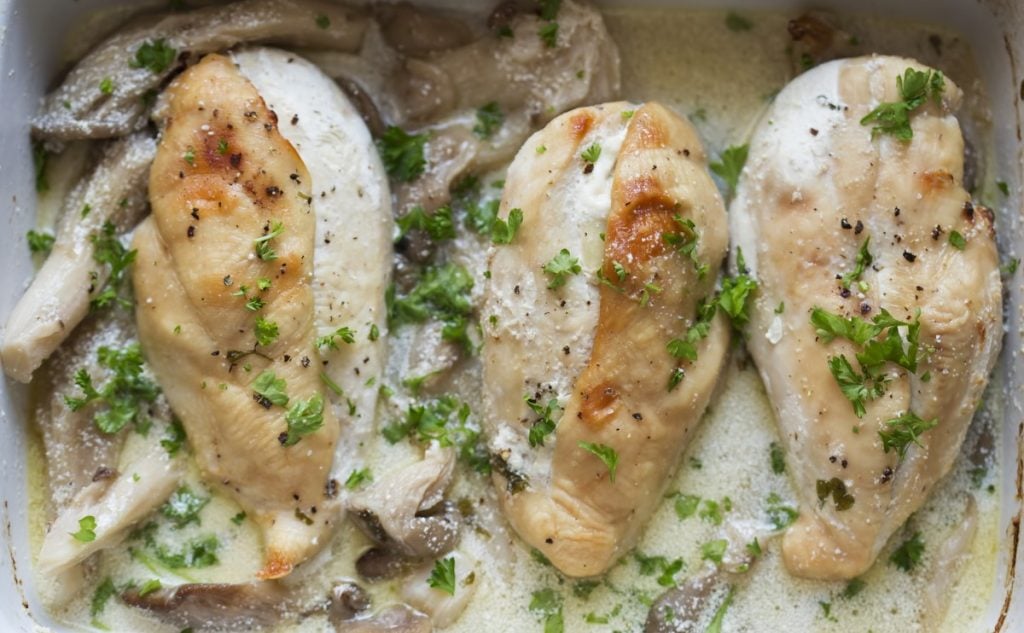
The elm oyster mushrooms in this creamy sauce are so meaty that it may feel like you’re eating double the chicken.
Ingredients:
- 8 bone-in, skin-on chicken pieces
- Salt and freshly ground black pepper to taste
- 2 tbsp unsalted butter
- 2 tbsp chopped fresh parsley
For the mushroom sauce:
- 1 tbsp unsalted butter
- 2 cloves garlic, minced
- 8 ounces (227 grams) of elm oyster mushrooms, thinly sliced
- 2 tbsp all-purpose flour
- 1 1/2 cups half and half (half whole milk and half heavy cream)
- 1/2 tsp dried thyme
- 1/2 tsp dried basil
- Pinch of crushed red pepper flakes
- Salt and freshly ground black pepper to taste
- Fresh parsley for garnish (optional)
Step 1: Preheat the oven to 400°F (200°C). Lightly coat a 9 x 13 baking dish with nonstick spray.
Step 2: Season chicken pieces with salt and pepper to taste.
Step 3: Melt 2 tablespoons of butter in a large skillet over medium-high heat. Add the chicken, skin-side down, and sear until both sides are golden brown, about 2 to 3 minutes per side.
Step 4: Place the chicken in the baking dish in a single layer, skin-side up. Put the chicken in the oven and roast until cooked, around 25 to 30 minutes.
Step 5: Prepare the mushroom sauce around 10 minutes before the chicken is ready. Melt a tablespoon of butter in the skillet. Add the garlic and elm mushrooms and cook, occasionally stirring, until tender and browned about 5-6 minutes.
Step 6: Whisk in flour and cook until lightly browned, about 1 minute.
Step 7: Gradually whisk in half and half, thyme, basil and crushed red pepper flakes and season with salt and pepper to taste. Then cook, while constantly whisking, until slightly thickened, about 3 to 4 minutes.
Step 8: Serve chicken with mushroom sauce immediately, garnished with parsley.
Final Thoughts
Elm oyster mushrooms are larger than other oyster mushrooms with a firm, meaty texture and light, delicate taste.
But as they often grow high up on tree branches where you can’t reach them, the best way to have an ongoing supply of these delicious mushrooms is to grow them yourself at home.
Like other oyster mushrooms, they’re some of the easiest mushrooms to grow, and you don’t need expensive equipment.
Our step-by-step introductory course to growing mushrooms at home shows you how to grow oysters on a small scale using simple methods and minimal equipment.
